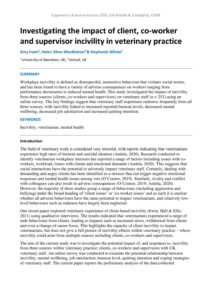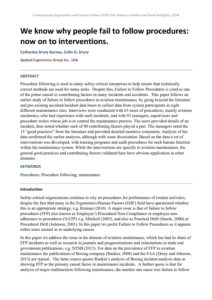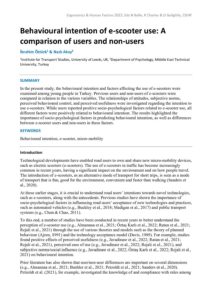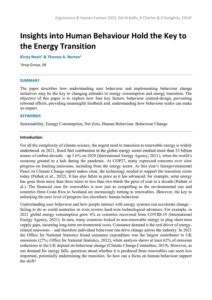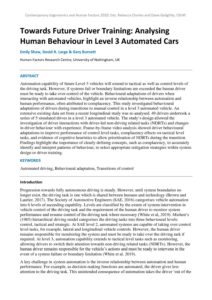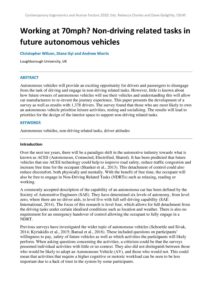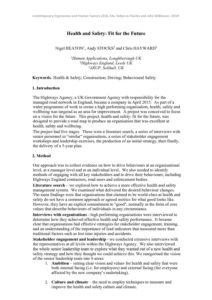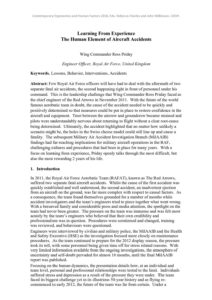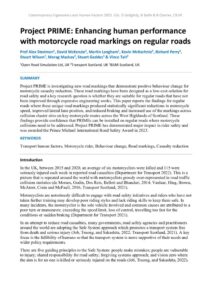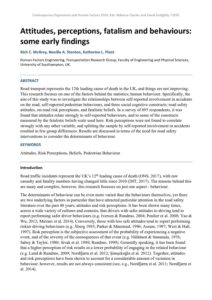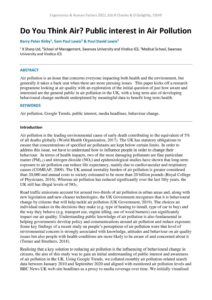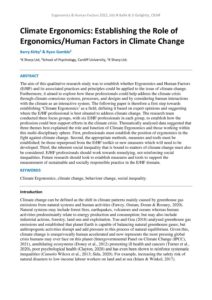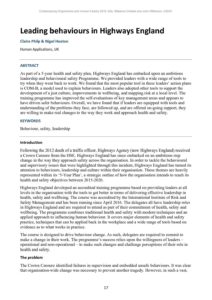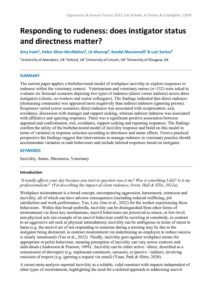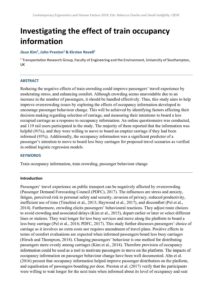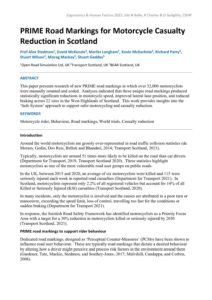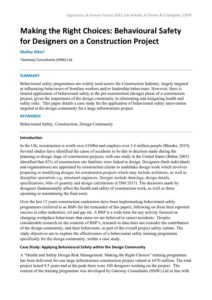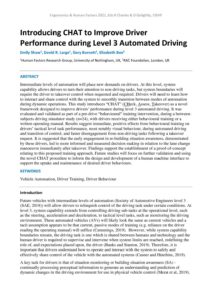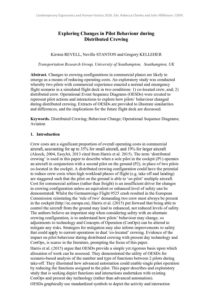Behaviour
Investigating the impact of client, co-worker and supervisor incivility in veterinary practice
| Document | Author Amy Irwin, Helen Silver-MacMahon & Stephanie Wilcke |
| Abstract Workplace incivility is defined as disrespectful, insensitive behaviour that violates social norms, and has been found to have a variety of adverse consequences on workers ranging from performance decrements to reduced mental health. This study investigated the impact of incivility from three sources (clients, co-workers and supervisors) on veterinary staff (n = 252) using an online survey. The key findings suggest that veterinary staff experience rudeness frequently from all three sources, with incivility linked to increased reported burnout levels, decreased mental wellbeing, decreased job satisfaction and increased quitting intention. |
We know why people fail to follow procedures: now on to interventions.
| Document | Author Catherine Drury Barnes, Colin G. Drury |
| Abstract Procedure following is used in many safety-critical enterprises to help ensure that technically correct methods are used for many tasks. Despite this, Failure to Follow Procedures is cited as one of the prime causal or contributing factors in many incidents and accidents. This paper follows an earlier study of failure to follow procedures in aviation maintenance, by going beyond the literature and pre-existing accident/incident data bases to collect data from system participants in eight different maintenance sites. Interviews were conducted with 63 users of procedures, mainly aviation mechanics, who had experience with such incidents, and with 92 managers, supervisors and procedure writes whose job is to control the maintenance process. The users provided details of an incident, then noted whether each of 90 contributing factors played a part. The managers rated the 15 “good practices” from the literature and provided detailed narrative comments. Analysis of the data confirmed the earlier analyses, although with some dissociation. Based on the data a set of interventions was developed, with training programs and audit procedures for each human function within the maintenance system. While the interventions are specific to aviation maintenance, the general good practices and contributing factors validated here have obvious application in other domains. |
Behavioural intention of e-scooter use: A comparison of users and non-users
| Document | Author İbrahim Öztürk & Nazlı Akay |
| Abstract In the present study, the behavioural intention and factors affecting the use of e-scooters were examined among young people in Turkey. Previous users and non-users of e-scooters were compared in relation to the various variables. The relationships of attitudes, subjective norms, perceived behavioural control, and perceived usefulness were investigated regarding the intention to use e-scooters. While users reported positive socio-psychological factors related to e-scooter use, all different factors were positively related to behavioural intention. The results highlighted the importance of socio-psychological factors in predicting behavioural intention, as well as differences between e-scooter users and non-users in these factors. |
Insights into Human Behaviour Hold the Key to the Energy Transition
| Document | Author Kirsty Novis & Thomas A. Norton |
| Abstract The paper describes how understanding user behaviour and implementing behaviour change initiatives may be the key to changing attitudes to energy consumption and energy transition. The objective of this paper is to explore how four key factors; behaviour centred-design, preventing rebound effects, providing meaningful feedback and, understanding how behaviour scales can make an impact. |
Towards Future Driver Training: Analysing Human Behaviour in Level 3 Automated Cars
| Document | Author Emily Shaw, David R. Large and Gary Burnett |
| Abstract Automation capability of future Level 3 vehicles will extend to tactical as well as control levels of the driving task. However, if systems fail or boundary limitations are exceeded the human driver must be ready to take over control of the vehicle. Behavioural adaptations of drivers when interacting with automated vehicles, highlight an inverse relationship between automation and human performance, often attributed to complacency. This study investigated behavioural adaptations of drivers during transitions to manual control in a level 3 automated vehicle. An extensive existing data set from a recent longitudinal study was re-analysed. 49 drivers undertook a series of 5 simulated drives in a level 3 automated vehicle. The study’s design allowed the investigation of driver interactions with driver-led non-driving related tasks (NDRTs) and changes in driver behaviour with experience. Frame-by-frame video analysis showed driver behavioural adaptations to improve performance of control level tasks, complacency effects on tactical level tasks, and evidence of cognitive heuristics to allow prioritisation of NDRTs during the transition. Findings highlight the importance of clearly defining concepts, such as complacency, to accurately identify and interpret patterns of behaviour, to select appropriate mitigation strategies within system design or driver training. |
Working at 70mph? Non-driving related tasks in future autonomous vehicles
| Document | Author Christopher Wilson, Diane Gyi and Andrew Morris |
| Abstract Autonomous vehicles will provide an exciting opportunity for drivers and passengers to disengage from the task of driving and engage in non-driving related tasks. However, little is known about how future owners of autonomous vehicles will use their vehicles and understanding this will allow car manufacturers to re-invent the journey experience. This paper presents the development of a survey as well as results with 1,378 drivers. The survey found that those who are most likely to own an autonomous vehicle prioritise leisure activities, resting and socialising. The results will lead to priorities for the design of the interior space to support non-driving related tasks. |
Health and Safety: Fit for the Future
| Document | Author Nigel HEATON, Andy STOCKS and Chris HAYWARD |
| Abstract |
Learning From Experience: The Human Element of Aircraft Accidents
| Document | Author Wing Commander Ross Priday |
| Abstract Few Royal Air Force officers will have had to deal with the aftermath of two separate fatal air accidents, the second happening right in front of personnel under his command. This is the leadership challenge that Wing Commander Ross Priday faced as the chief engineer of the Red Arrows in November 2011. With the future of the world famous aerobatic team in doubt, the cause of the accident needed to be quickly and positively determined so that measures could be put in place to restore confidence in the aircraft and equipment. Trust between the aircrew and groundcrew became strained and pilots were understandably nervous about returning to flight without a clear root-cause being determined. Ultimately, the accident highlighted that no matter how unlikely a scenario might be, the holes in the Swiss cheese model could still line up and cause a fatality. The subsequent Military Air Accident Investigation Branch (MilAAIB) findings had far-reaching implications for military aircraft operations in the RAF, challenging cultures and procedures that had been in place for many years. With a focus on learning from experience, Priday openly talks through the most difficult, but also the most rewarding 2 years of his life. |
Project PRIME: Enhancing human performance with motorcycle road markings on regular roads
| Document | Author Alex Stedmon, David McKenzie, Martin Langham, Kevin McKechnie, Richard Perry, Stuart Wlison, Morag Mackay, Stuart Geddes & Vince Tait |
| Abstract Project PRIME is investigating new road markings that demonstrate positive behaviour change for motorcycle casualty reduction. These road markings have been designed as a low-cost solution for road safety and a key research question is whether they are suitable for regular roads that have not been improved through expensive engineering works. This paper reports the findings for regular roads where these unique road markings produced statistically significant reductions in motorcycle speed, improved lateral lane position, and reduced braking and increased use of the markings across collision cluster sites on key motorcycle routes across the West Highlands of Scotland. These findings provide confidence that PRIMEs can be installed on regular roads where motorcycle collisions need to be addressed. Project PRIME has demonstrated major impact in rider safety and was awarded the Prince Michael International Road Safety Award in 2023. |
Attitudes, perceptions, fatalism and behaviours: some early findings
| Document | Author Rich C. McIlroy, Neville A. Stanton, Katherine L. Plant |
| Abstract Road transport represents the 12th leading cause of death in the UK, and things are not improving. This research focuses on one of the factors behind the statistics; human behaviour. Specifically, the aim of this study was to investigate the relationships between self-reported involvement in accidents on the road, self-reported pedestrian behaviours, and three social cognitive constructs; road safety attitudes, on-road risk perceptions, and fatalistic beliefs. In a survey of 695 respondents, it was found that attitudes relate strongly to self-reported behaviours, and to some of the constructs measured by the fatalistic beliefs scale used here. Risk perceptions were not found to correlate strongly with any other variable, and splitting the sample by self-reported involvement in accidents resulted in few group differences. Results are discussed in terms of the need for road safety interventions to consider the determinants of behaviour. |
Do You Think Air? Public interest in Air Pollution
| Document | Author Barry Peter Kirby, Sam Paul Lewis & Paul David Lewis |
| Abstract Air pollution is an issue that concerns everyone impacting both health and the environment, but generally it takes a back seat when there are more pressing issues. This paper kicks off a research programme looking at air quality with an exploration of the initial question of just how aware and interested are the general public in air pollution in the UK, with a long term aim of developing behavioural change methods underpinned by meaningful data to benefit long term health. |
Climate Ergonomics: Establishing the Role of Ergonomics/Human Factors in Climate Change
| Document | Author Barry Kirby & Ryan Gamble |
| Abstract The aim of this qualitative research study was to establish whether Ergonomics and Human Factors (E/HF) and its associated practices and principles could be applied to the issue of climate change. Furthermore, it aimed to explore how these professionals could help address the climate crisis through climate-conscious systems, processes, and designs and by considering human interactions with the climate as an interactive system. The following paper is therefore a first step towards establishing ‘Climate Ergonomics’ as a field, defining it based on expert opinions and suggesting where the E/HF professional is best situated to address climate change. The research team conducted three focus groups, with six E/HF professionals in each group, to establish how the profession could best support efforts in the climate crisis. Thematically analysed data suggested that three themes best explained the role and function of Climate Ergonomics and those working within this multi-disciplinary sphere. First, professionals must establish the position of ergonomics in the fight against climate change. Second, the appropriate methods, measures and tools must be established; be those repurposed from the E/HF toolkit or new measures which will need to be developed. Third, the inherent social inequality that is bound to matters of climate change must also be considered. E/HF professionals should work towards remedying, not reinforcing social inequalities. Future research should look to establish measures and tools to support the measurement of sustainable and socially responsible practice in the E/HF domain. |
Leading behaviours in Highways England
| Document | Author Claire Philp & Nigel Heaton |
| Abstract As part of a 5-year health and safety plan, Highways England has embarked upon an ambitious leadership and behavioural safety Programme. We provided leaders with a wide range of tools to try when they went back to work. We found that the most popular tool in these leaders’ action plans is COM-B, a model used to explain behaviours. Leaders also adopted other tools to support the development of a just culture, improvements in wellbeing, and mapping risk at a local level. The training programme has improved the self-evaluations of key management areas and appears to have driven safer behaviours. Overall, we have found that if leaders are equipped with tools and understanding of the problems they face, are followed up, and are offered on-going support, they are willing to make real changes to the way they work and approach health and safety. |
Responding to rudeness: does instigator status and directness matter?
| Document | Author Amy Irwin, Helen Silver-MacMahon, Liz Mossop, Kendyl Macconnell & Luiz Santos |
| Abstract The current paper applies a biobehavioural model of workplace incivility to explore responses to rudeness within the veterinary context. Veterinarians and veterinary nurses (n=132) were asked to evaluate six fictional scenarios depicting two types of rudeness (direct versus indirect) across three instigators (clients, co-workers and senior colleagues). The findings indicated that direct rudeness (demeaning comments) was appraised more negatively than indirect rudeness (ignoring person). Responses varied across scenarios; direct rudeness was associated with reciprocation, exit, avoidance, discussion with manager and support seeking, whereas indirect rudeness was associated with affiliative and ignoring responses. There was a significant positive association between appraisal and confrontation, exit, avoidance, support seeking and reporting responses. The findings confirm the utility of the biobehavioural model of incivility response and build on this model in terms of variation in response selection according to directness and status effects. From a practical perspective the findings suggest that interventions to manage rudeness in veterinary practice should accommodate variation in rude behaviours and include tailored responses based on instigator. |
Investigating the effect of train occupancy information
| Document | Author Jisun Kim, John Preston & Kirsten Revell |
| Abstract Reducing the negative effects of train crowding could improve passengers’ travel experience by moderating stress, and enhancing comfort. Although crowding seems unavoidable due to an increase in the number of passengers, it should be handled effectively. Thus, this study aims to help improve overcrowding issues by exploring the effects of occupancy information developed to encourage passenger behaviour change. This will be achieved by identifying factors affecting their decision making regarding selection of carriage, and measuring their intentions to board a less occupied carriage as a response to occupancy information. An online questionnaire was conducted, and 119 rail users participated in the study. The majority of them reported that the information was helpful (91%), and they were willing to move to board an emptier carriage if they had been informed (93%). Additionally, the occupancy information was a significant predictor of a passenger’s intention to move to board less busy carriages for proposed travel scenarios as verified in ordinal logistic regression models. |
PRIME Road Markings for Motorcycle Casualty Reduction in Scotland
| Document | Author Prof Alex Stedmon, David McKenzie, Martin Langham, Kevin McKechnie, Richard Perry, Stuart Wlison, Morag Mackay, Stuart Geddes |
| Abstract This paper presents research of new PRIME road markings in which over 32,000 motorcyclists were manually counted and coded. Analyses indicated that these unique road markings produced statistically significant reductions in motorcycle speed, improved lateral lane position, and reduced braking across 22 sites in the West Highlands of Scotland. This work provides insights into the ‘Safe System’ approach to support safer motorcycling and casualty reduction. |
Making the Right Choices: Behavioural Safety for Designers on a Construction Project
| Document | Author Shelley Stiles |
| Abstract Behavioural safety programmes are widely used across the Construction Industry, largely targeted at influencing behaviours of frontline workers and/or leadership behaviours. However, there is limited application of behavioural safety at the pre-construction (design) phase of a construction project, given the importance of the design community in eliminating and mitigating health and safety risks. This paper details a case study for the application of behavioural safety intervention targeted at the design community for a large infrastructure project. |
Introducing CHAT to Improve Driver Performance during Level 3 Automated Driving
| Document | Author Emily Shaw, David R. Large, Gary Burnett, Elizabeth Box |
| Abstract Intermediate levels of automation will place new demands on drivers. At this level, system capability allows drivers to turn their attention to non-driving tasks, but system boundaries will require the driver to takeover control when requested and required. Drivers will need to learn how to interact and share control with the system to smoothly transition between modes of automation during dynamic operations. This study introduces “CHAT” (CHeck, Assess, Takeover) as a novel framework designed to improve drivers’ performance during level 3 automated driving. It was evaluated and validated as part of a pre-drive “behavioural” training intervention, during a between-subjects driving simulator study (n=24), with drivers receiving either behavioural training or a written operating manual. Results suggest immediate, positive effects from behavioural training on drivers’ tactical level task performance, most notably visual behaviour, during automated driving and transition of control, and faster disengagement from non-driving tasks following a takeover request. It is suggested that the early engagement in re-building situation awareness, demonstrated by these drivers, led to more informed and measured decision making in relation to the lane change manoeuvre immediately after takeover. Findings support the establishment of a proof-of-concept relating to this proposed training approach. Future studies will focus on further validation and using the novel CHAT procedure to inform the design and development of a human machine interface to support the uptake and maintenance of desired driver behaviours. |
Exploring Changes in Pilot Behaviour during Distributed Crewing
| Document | Author Kirsten REVELL, Neville STANTON and Gregory KELLEHER |
| Abstract Changes to crewing configurations in commercial planes are likely to emerge as a means of reducing operating costs. An exploratory study was conducted whereby two pilots with commercial experience enacted a normal and emergency flight scenario in a simulated flight deck in two conditions: 1) co-located crew, and; 2) distributed crew. Operational Event Sequence Diagrams (OESDs) were created to represent pilot actions and interactions to explore how pilots’ behaviour changed during distributed crewing. Extracts of OESDs are provided to illustrate similarities and differences, and the implications for the future flight deck are discussed. |

